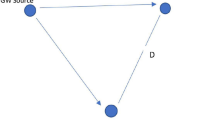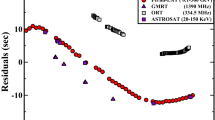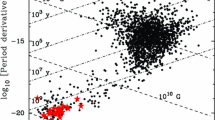Abstract
This paper summarizes parallel session C1: Pulsar Timing Arrays of the Amaldi10/GR20 Meeting held in Warsaw, Poland in July 2013. The session showcased recent results from pulsar timing array collaborations, advances in modelling the gravitational-wave signal, and new methods to search for and characterize gravitational waves in pulsar timing array observations.

Similar content being viewed by others
References
Sesana, A., Vecchio, A., Colacino, C.N.: The stochastic gravitational-wave background from massive black hole binary systems: implications for observations with pulsar timing arrays. MNRAS 390, 192 (2008)
Sesana, A.: Systematic investigation of the expected gravitational wave signal from supermassive black hole binaries in the pulsar timing band. MNRAS 433, 1 (2013)
McConnell, N.J., Ma, C.-P.: Revisiting the scaling relations of black hole masses and host galaxy properties. Astrophys. J. 764, 184 (2013)
Hlavacek-Larrondo, J., et al.: On the hunt for ultramassive black holes in brightest cluster galaxies. MNRAS 424, 224 (2012)
Shannon, R.M., et al.: Gravitational-wave limits from pulsar timing constrain supermassive black hole evolution. Science 342, 334 (2013)
van Haasteren, R., Levin, Y., McDonald, P., Lu, T.: On measuring the gravitational-wave background using pulsar timing arrays. MNRAS 395, 1005 (2009)
Ölmez, S., Mandic, V., Siemens, X.: Gravitational-wave stochastic background from kinks and cusps on cosmic strings. Phys. Rev. D 81, 104028 (2010)
Starobinskiǐ, A.A.: Spectrum of relict gravitational radiation and the early state of the universe. Sov. J. Exp. Theor. Phys. Lett. 30, 682 (1979)
Caprini, C., Durrer, R., Siemens, X.: Detection of gravitational waves from the QCD phase transition with pulsar timing arrays. Phys. Rev. D 82, 063511 (2010)
Jaffe, A.H., Backer, D.C.: Gravitational waves probe the coalescence rate of massive black hole binaries. Astrophys. J. 583, 616 (2003)
Sesana, A., Vecchio, A., Volonteri, M.: Gravitational waves from resolvable massive black hole binary systems and observations with pulsar timing arrays. MNRAS 394, 2255 (2009)
Detweiler, S.: Pulsar timing measurements and the search for gravitational waves. Astrophys. J. 234, 1100 (1979)
Hellings, R.W., Downs, G.S.: Upper limits on the isotropic gravitational radiation background from pulsar timing analysis. Astrophys. J. 265, L39 (1983)
Anholm, M., Ballmer, S., Creighton, J.D.E., Price, L.R., Siemens, X.: Optimal strategies for gravitational wave stochastic background searches in pulsar timing data. Phys. Rev. D 79, 084030 (2009)
Wen, L., Chen, Y.: Geometrical expression for the angular resolution of a network of gravitational-wave detectors. Phys. Rev. D 81, 082001 (2010)
Boyle, L., Pen, U.-L.: Pulsar timing arrays as imaging gravitational wave telescopes: angular resolution and source (de)confusion. Phys. Rev. D 86, 124028 (2012)
Wen, L., Schutz, B.F.: Coherent network detection of gravitational waves: the redundancy veto. Class. Quantum Gravit. 22, 1321 (2005)
Chatterji, S., et al.: Coherent network analysis technique for discriminating gravitational-wave bursts from instrumental noise. Phys. Rev. D 74, 082005 (2006)
Wen, L.: Data analysis of gravitational waves using a network of detectors. Int. J. Mod. Phys. D 17, 1095 (2008)
Ellis, J.A.: A Bayesian analysis pipeline for continuous GW sources in the PTA band. Class. Quantum Gravit. 30, 224004 (2013)
Ellis, J.A., Siemens, X., Creighton, J.D.E.: Optimal strategies for continuous gravitational wave detection in pulsar timing arrays. Astrophys. J. 756, 175 (2012)
Manchester, R.N., et al.: The parkes pulsar timing array project. PASA 30, 17 (2013)
Ferdman, R.D., et al.: The European pulsar timing array: current efforts and a LEAP toward the future. Class. Quantum Gravit. 27, 084014 (2010)
Hobbs, G., et al.: The international pulsar timing array project: using pulsars as a gravitational wave detector. Class. Quantum Gravit 27, 084013 (2010)
Demorest, P.B., et al.: Limits on the stochastic gravitational wave background from the North American nanohertz observatory for gravitational waves. Astrophys. J. 762, 94 (2013)
Mingarelli, C.M.F., Sidery, T., Mandel, I., Vecchio, A.: Characterizing gravitational wave stochastic background anisotropy with pulsar timing arrays. Phys. Rev. D 88(8), 062005 (2013)
Taylor, S.R., Gair, J.R.: Searching for anisotropic gravitational-wave backgrounds using pulsar timing arrays. Phys. Rev. D 88(8), 084001 (2013)
van Haasteren, R.: Accelerating pulsar timing data analysis. Mon. Not. R. Astron. Soc. 429, 55–62 (2013)
Ravi, V., Wyithe, J.S.B., Hobbs, G., et al.: Does a “stochastic” background of gravitational waves exist in the pulsar timing band? Astrophys. J. 761, 84 (2012)
Hobbs, G.B., Edwards.: The Australia Telescope Compact Array (/ Parkes radio telescope / Mopra radio telescope / Long Baseline Array) is part of the Australia Telescope National Facility which is funded by the Commonwealth of Australia for operation as a National Facility managed by CSIRO. R. T., & Manchester, R. N. 2006, MNRAS, 369, 655
Cornish, N.J., Sesana, A.: Pulsar timing array analysis for black hole backgrounds. Class. Quantum Gravit. 30, 224005 (2013)
Corbin, V., Cornish, N.J.: Pulsar timing array observations of massive black hole binaries arXiv:1008.1782 (2010)
Deng, X., Finn, L.S.: Pulsar timing array observations of gravitational wave source timing parallax. MNRAS 414, 50 (2011)
Lee, K.J., et al.: Gravitational wave astronomy of single sources with a pulsar timing array. MNRAS 414, 3251 (2011)
Rosado, P.A., Sesana, A.: Targeting supermassive black hole binaries and gravitational wave sources for the pulsar timing array. MNRAS, arXiv:1311.0883 (2013, submitted to)
York, D.G., et al.: The sloan digital sky survey: technical summary. Astrophys. J. 120, 1579 (2000)
Abazajian, K., et al.: The seventh data release of the sloan digital sky survey. Astrophys. J. Suppl. 182, 543 (2009)
Springel, V., et al.: Simulations of the formation, evolution and clustering of galaxies and quasars. Nature 435, 629 (2005)
Guo, Q., et al.: From dwarf spheroidals to cD galaxies: simulating the galaxy population in a \(\Lambda \)CDM cosmology. MNRAS 413, 101 (2011)
Ellison, S.L., et al.: Galaxy pairs in the Sloan Digital Sky Survey- VIII. The observational properties of post-merger galaxies. MNRAS 435, 3627 (2013)
Hobbs, G., et al.: Development of a pulsar-based time-scale. MNRAS 427, 2780 (2012)
McWilliams, S.T., Ostriker, J.P., Pretorius, F.: Gravitational waves and stalled satellites from massive galaxy mergers at \(z \le 1\). arXiv:1211.5377 (2012)
Acknowledgments
LW acknowledges funding support from Australian Research Council.
Author information
Authors and Affiliations
Corresponding author
Additional information
This article belongs to the Topical Collection: The First Century of General Relativity: GR20/Amaldi10.
Rights and permissions
About this article
Cite this article
Shannon, R.M., Chamberlin, S., Cornish, N.J. et al. Summary of session C1: pulsar timing arrays. Gen Relativ Gravit 46, 1765 (2014). https://doi.org/10.1007/s10714-014-1765-4
Received:
Accepted:
Published:
DOI: https://doi.org/10.1007/s10714-014-1765-4




